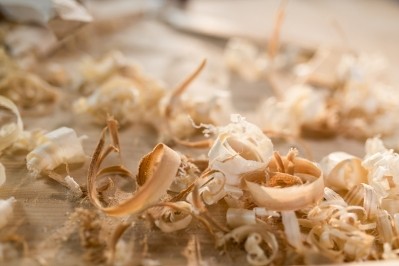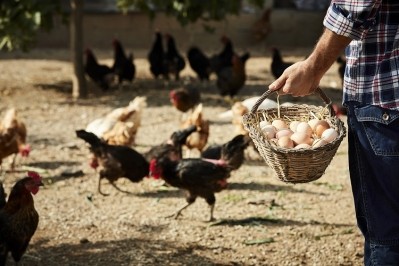It’s been a challenging year for the world of start-ups, with investment thin on the ground in some areas. According to innovation charity Nesta, venture capital investment into food tech start-ups reached a high in 2021, but dropped off by more than half in 2022.
We’re yet to see start-up valuations completely rebound, but inflation is easing and those with a glass-half-full mentality will be optimistic for the future. As Martin Davos, partner at food tech and food service investment firm McWin Partners said recently: “The best companies are created in times of crisis. The best entrepreneurs are also forged in times of crisis.”
Looking back at 2023, it’s clear that challenging economic environments don’t halt innovation. This year, we’ve met a wide range of innovative food start-ups, and as we move into December, we thought it fitting to round up five of the most innovative.
From a start-up upcycling ‘spent hens’ into flavour enhancers to another producing breast milk in a lab, here are five start-ups that caught our eye in 2023.
Vegbloc: Substituting, but not mimicking, meat
First up is Vegbloc, a UK-based start-up that has yet to reach the market. What sets Vegbloc apart is not that it’s making plant-based meat substitutes – we’ve seen that category become increasingly saturated – but that it’s approaching meat substitutes through a different lens.
Vegbloc is completely disinterested in meat mimicry: the newcomer does not look, smell, or taste like the real thing, and nor does it intend to.
That means that you won’t find extruded pea or soy protein isolates on the ingredients list. Instead, the meat substitute is made from quinoa, red lentils, split peas, flax seed, onion, chia seed, gram flour, rosemary, sweet potato, mushroom, garlic, nutritional yeast, smoked paprika, salt, mushroom powder, coriander and black pepper.
As a nice aside, its carbon footprint is more than 30 times lower than that of beef.
“We are upfront about the ingredients of Vegbloc and it is attracting the attention of meat-eaters who are suspicious of ‘fake meats’, as well as scratch cook vegans/vegetarians/reducers who would like a more convenient option that is still natural,” co-founder Simon Day told FoodNavigator in June. (If Day’s name sounds familiar, it’s because he is also the founder of start-up festival Bread & Jam in London).
In moving away from meat mimicry, Day foresees potential to appeal to consumers across the UK and even Europe. The concept is already, in its prototype stage, proving popular amongst consumers. “Once you have shed the straitjacket of mimicry, you can drop highly processed and undesirable ingredients and you are free to create really nutritious products with their own delicious taste and texture…
“The first reaction is that this is something genuinely new and that it’s refreshing that we have created something with its own texture and flavour that isn’t trying to mimic meat!”
FoodNavigator’s article Vegbloc: Meet the start-up substituting, not imitating, meat with a clean label can be read in full here.
ÄIO: Turning sawdust into food
Estonian start-up ÄIO started life at Tallinn University of Technology, where Petri-Jaan Lahtvee and Nemailla Bonturi worked together to produce edible fats and oils from agricultural and wood side-streams.

Now coming up to its two-year anniversary, ÄIO believes its solution can help offer alternatives to tropical oils and animal fats for multiple industries, including food.
Hard vegetable fats are currently used for many purposes, ranging from food formulation to cosmetics. But palm, coconut, shea and cocoa can only be grown in the tropics and bring environmental sustainability concerns. The solutions, according to ÄIO’s founders, is to use fermentation processes to deliver new fats and oils they claim are rich in fatty acids and antioxidants.
ÄIO uses a ‘red bug’ microbe – created and patented by Bonturi – which feeds on side streams from agriculture, food and wood industries, such as sawdust, lactose and molasses. “In the same way that we make kombucha, yogurt, bread, and beer, we can turn sawdust or other low-value biomass into valuable and healthy ingredients,” said Bonturi. “Our ‘red bug’ cannot turn water into wine, but it can turn sawdust into food.”
Next up, ÄIO wants to increase production capacity, test products in cooperation with food industry players, and apply for novel food permits to enter the European market. The start-up hopes to start producing its fats and oils at industrial scale by 2026.
This year, the start-up raised €1m from investors including Nordic Foodtech VC and the Estonian Business Innovation Agency.
Our full article Upcycling sawdust to make alternative oils and fats is available to read here.
Nūmi: Replacing infant formula with cultivated breast milk
Just last month, we caught up with co-founder of French biotech start-up Nūmi Eden Banon, who together with Eugenie Peze-Heidsieck is looking to replace ‘inadequate’ infant formula.
The issue is that the vast majority of baby formula on the market is made from bovine milk, with a small percentage made with from soy and rice. Whether made from cow’s milk, grains or legumes, current offerings are not up to scratch, explained Banon.
“The complexity of breast milk answers all the needs for babies’ development, ranging from brain and retina development to satiety regulators and boosting the immune system. It’s composed of over 1,500 constituents and trying to replicate that coming from another species is suboptimal.”
So instead of sticking with the status quo of cow’s milk-based formula, Nūmi is turning to cell culture to reproduce human milk from mammary cells. Cell culture technology involves growing cells under controlled conditions, usually outside of their natural environment. Nūmi is recreating the mammary gland environment (the organ responsible for milk synthesis) for human cells to development produce milk.
“We use multiple sources of effective cell lines and cultivate them in controlled conditions,” we were told. Specifically, the team isolates selected cells, cultivates them in controlled conditions, and feeds them nutrients to grow, duplicate, and produce human milk. The final step is purification, before being ready for human consumption.
“Cell culture technology allows you to replicate the whole phenomenon of lactation in vivo, in vitro using what nature does best – but now with the help of science.”
Nūmi will need to file for pre-market authorisation before entering the market, and Banon expects it will initially launch in the US. “The US…is more welcoming of innovations in this field and have set up a more defined regulatory landscape for innovations like ours, while Europe is still evolving.
“We very much hope that Europe will follow and that we’ll be able to bring our products to European and French families quite soon.”
Our full article Cell-based breast milk in development to replace ‘suboptimal’ bovine infant formula is available to read here.
Rice in Action: Healthier, more sustainability rice

Rice is a staple crop for more than 3.5bn people around the world. Having been cultivated as far back as 5000 years BC, rice innovation – outside of plant breeding and genetic modification to improve sustainability credentials – is rare.
But in Spain, the ancient grain has been revamped by start-up Rice in Action. Using proprietary technology, Rice in Action has lowered rice’s glycaemic index and its cooking time, with benefits for health, sustainability and productivity.
The start-up claims its rice can offer foodservice clients a 12-fold increase in productivity, while cutting energy costs sixty-fold.
Without going too much into the patent pending technology, Rice in Action cold infuses rice with broths, flavours and nutrients in a ‘precise way’. The rice can be booked in just two to four minutes, without the need to add water or broth. “We have turned a universal and delicious ingredient – but one that is often complicated due to lack of culinary skills and hectic lifestyles – into an ideal speed scratch cooking ingredient,” Christophe Pais, co-founder of the Madrid-based start-up, told FoodNavigator earlier this year.
At the same time, the ‘minimal processing’ completely changes the rice’s nutritional properties to include a higher proportion of slowly digestible starch (SDS), cutting its glycaemic response. “If traditional cooked rice has 24% SDS our rice has 52%. This means that it releases sustained energy without causing blood glucose spikes. Our GI [glycaemic index] is only 23 when the GI of white rice is 70.
“On top of that, our rice can be infused with nutrients in a precise way, so we can manufacture highly targeted nutrition meals for specific age groups.”
Our full article This opens up a new category’: Meet the start-up making a ‘game-changing’ low GI, quicker-cooking rice is available to read here.
Reduced: Making flavour enhancers from the ugly side of poultry production
Another upcycling start-up that caught our attention in 2023 was Copenhagen-based Reduced. The company has joined forces with ingredients suppler Caldic to explore and scale upcycled ingredients for food makers in the Nordics and Baltic states.

But Reduced is not working with the more common brewer’s spent grain or yeast. Instead, the biotech is looking to spent hens, which it describes as an ‘untapped resource’.
The term ‘spent hens’ is used to describe chickens at the end of their egg-laying cycle. With meat that is too tough to eat, their commercial value is usually low. Often, they are processed into ‘chick pulp’ for use in animal feed or biogas production. Other times they are discarded. In Denmark alone, 8m kilos of organic chickens are wasted per year.
Reduced is using fermentation techniques at industrial scale, combining fungi with chicken and extracting the ‘super umami-rich liquid’ at the end. The liquid, which can be used as a flavour enhancer, is certified organic and approved by food authorities, we were told.
Together with Caldic, Reduced is also looking at using Danish organic button mushrooms to produce umami flavouring. Industrial producers of Agaricus Bisporus mushrooms, which make up 45% of global mushroom production, have an 8-10% waste rate on all production every year, Reduced co-founder Emil Munck de Voss told FoodNavigator.
“For our partner in Denmark, that amounts to 203 tonnes of wasted organic Agaricus Bisporus a year. The mushrooms we are using usually are discarded for retail sales because they are too large, or too small to be packaged, broken or bruised. We use them for organic, clean label and great-tasting food ingredients and thereby we reduce food waste.”
The flavour enhancers aim to boost umami taste in food formulation without additives. To date, they have been used in meat products, meat hybrids and meat alternatives to reduce raw material costs, lower salt content and enhance flavour.
“Our ingredients have the potential to lower costs by enabling the creation of meat hybrids,” said de Voss. “Through a series of formulations, we have demonstrated that meat content in processed meat products can be reduced by 5-20% and substituted with vegetables and our flavour enhancers.
“This not only maintains the great taste but also lowers the cost by removing expensive meat content. We have demonstrated cost savings in between 5-10% working with formulations of sausages and beef patties.”
Our full article Embracing ugly veg and the ugly side of poultry production to make more profitable and sustainable products is available to read here.
